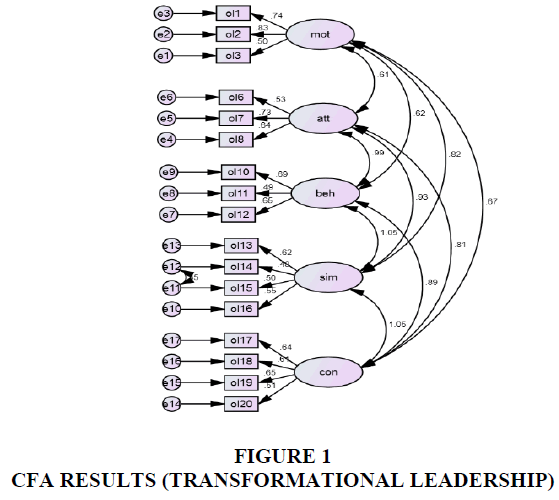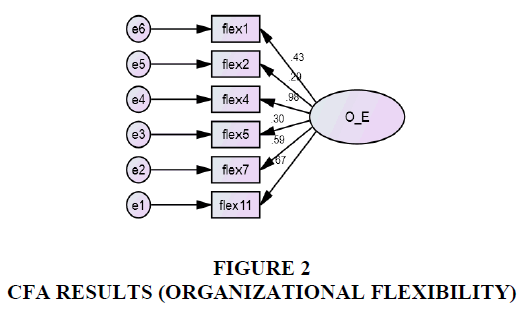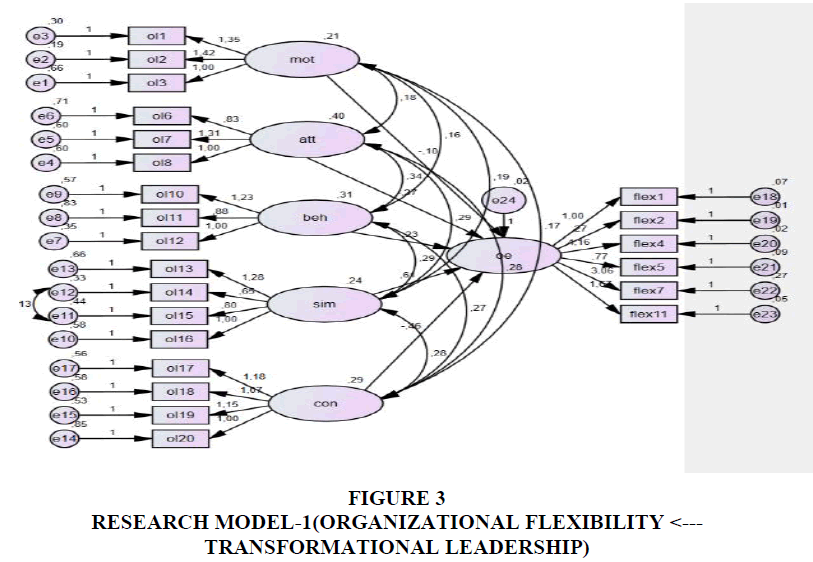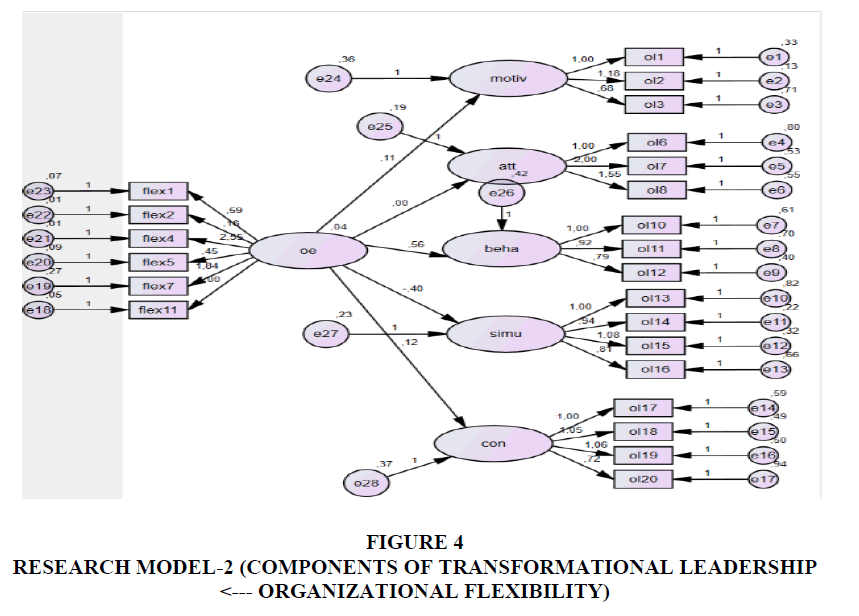Research Article: 2020 Vol: 19 Issue: 3
The Direction of the Interactive Relation between Organizational Flexibility and Transformational Leadership Behaviours: A Comparative Analysis
Bulent Akkaya, Manisa Celal Bayar University
Yesim Kocyigit, Istanbul Gelisim Universtiy
Abstract
Leadership and organizational flexibility are closely related. Each component of the organizational flexibility and transformational leadership affects the adapting of organization to environmental changes. But, which of them is antecedent of the other is still a question in literature. To answer this question, in this research two models were tested and goodness of fit of models was compared by using SEM (Structural Equation Modelling). The data were collected form 217 participants who work as bottom/middle level managers in SMEs in Turkey. The results showed that organizational flexibility is the antecedent of the transformational leadership.
Keywords
Organizational Flexibility, Transformational Leadership, Motivation.
Introduction
Leaders and organizational structures have important roles in achieving the aims of organizations. Especially, the needs for transformational leadership behaviours and organizational flexibility are much more than ever, when needing to the gradual or dramatic changes in order to adapt to environmental changes. Because transformational leadership motivates and stimulates their followers (subordinates, counterparts, superiors, or other stakeholders) for change and adaptation, it provides to change their attitudes, values, levels of passion and enables them to make extra efforts for the aims of the organization. On the other hand, organizational structure plays an important role in learning, being innovative, and creating more value for customers in order to adapt to change. Especially flexible organizations allow using several tools such as organization, technology, human, and innovation in interaction in order to cope with changes.
As understood from statements aforesaid, each of the variables affects adapting to environmental changes. But, it is important to know which of them is antecedent of the other. Some of research has been conducted to explain the relation between transformational leadership and organizational structure (Garg & Krishnan, 2003; Shahzad et al., 2018), but limited research focuses on the effect of variables on each other. Although there are some studies that affirm that organizational structure is crucial for leadership style in the past literature, the number of them has not been a lot (Shamir &Howell, 1999; Zhu & Bao, 2017). Similarly, studies that investigate the effect of transformational leadership behaviour on the organizational structure or flexibility aren't a lot (Saeid & Behzad, 2014; Andrej et al., 2020). This is an evident gap in the literature. This study contributes to the literature by investigating the antecedent in the relationship between organizational structure and transformational leadership style.
In order to learn the answer to the question which of them is antecedent of the other, two models were created, analysed, and compared to goodness of fit of models. So that the models could be compared, the data used in the analyses gained from the senior managers 217 participants who work as bottom/middle level managers in SMEs in Turkey. According to the results of the study, it discussed which of the variable need to be considered as a valuable source.
The comparison of the models is essential in providing guidelines for the development of effectiveness of the leadership and organizational structure. Suggestions in this study can be adopted by the founders of the organizational structure and human resource personnel in order to improve the adaptation to dynamic and unstable environment.
The research contains five sections: a literature section presenting a conceptual framework and reviewing on previous research to emphasize the models; subsequently, the purpose and hypothesis are described; the sample and measures are explained in the methodology section; after, the results are presented and interpreted; conclusions are discussed and implications are presented in the final section.
Literature Review
Leaders play a very important role in success for organizations that try to continue their activities in a dynamic and unstable environment that substantially increases the needs to the change, transformation, and adaptation. In order to adapt to such an environment, the leader must be able to apply the necessary gradual or dramatic changes, encourage innovative thinking, and determine the ideal future in the environment of uncertainty. By clarifying the ideal future for its followers, leaders should motivate and guide them to reach the ideal future. Transformational leadership can arise when leaders are empowered for change, innovation, and flexibility to adapt to such a dynamic and uncertain environment. Because transformational leadership motivates and stimulates their followers (subordinates, counterparts, superiors, or other stakeholders) for change and adaptation, it provides to change their attitudes, values, levels of passion and enables them to make extra efforts for the aims of the organization.
Transformational leadership is based on the ideas of Burns (1978). According to Burns (1978), transformational and transactional leadership styles are opposed to each other. Transactional leaders shape followers' actions by using mutual interests to be obtained. Whereas, by emphasizing moral and ethical values, transformational leaders ensure their followers to use their energy and resources in order to make sacrifices for the organization. Thus transformational leaders try to constitute a new form for their organizations. Many theories about transformational leadership have been proposed, but the theory developed by Bass (1985) has been the most influential in leadership research. According to this theory, transformational leadership includes three sub-dimensions: idealized influence, intellectual stimulation and individualized consideration. Thanks to the last two updates made by Bass & Avolio (1990, 1997, 1999), transformational leadership has been constituted by sub-dimensions such as the idealized influence- attributes, idealized influence- behaviour, inspirational motivation, intellectual stimulation, and individualized consideration (Yukl, 2013).
On the other hand, Martinez-Leon & Martinez-Gracia (2011) stated that organizational structure plays an important role in learning, being innovative, and creating more value for customers in order to adapt to change. The important alternatives for organizational structure are mechanistic and organic structures suggested by Burns & Stalker (1961). Mechanistic structure is suitable for the context that people need to traditionally and expectedly act. On the other hand, the organic structure enables the flexibility to cope with changes (Shahzad et al., 2018). Organizational flexibility can be defined as firms being flexibility not only in a discipline or department but in all disciplines or departments. It is defined as the ability to respond to unpredicted change and the capacity to determine the level of firms may exercise in uncertain environments (Phillips & Wright, 2009). Researchers have explained and emphasized the role of organizational flexibility to respond to changing market conditions (Sethi & Sethi, 1990; Gerwin, 1993; Upton, 1994).
As understood from statements aforesaid, each of the variables affects adapting to environmental changes. But, it is important to know which of them is antecedent of the other. Some of research has been conducted to explain the relation between transformational leadership and organizational structure (Garg & Krishnan, 2003; Shahzad et al., 2018), but limited research focuses on the effect of variables on each other. Although there are some studies that affirm that organizational structure is crucial for leadership style in the past literature, the number of them has not been a lot (Shamir & Howell, 1999; Zhu & Bao, 2017). Shamir & Howell (1999) stated in their study that organizations facing uncertain and turbulent environments must tend to be more flexible, organic structures are suitable for organizations of this context. They claimed that in organic organizations, commitment to the organization’s mission is very high, they enable and encourage the expression of individual behaviour by both leaders and potential followers, thus organic organizations enable to transformational leadership behaviours. But they didn't carry out any empirical study to prove this claim. Zhu & Bao (2017) investigated the role of transformational leadership in different organizational structures. The results have shown that transformational leadership are substitutive when the organizational structure is mechanistic, and are complementary when the structure is organic. Organizational structure has been handled as the antecedent of transformational leadership in these studies.
Similarly, studies that investigate the effect of transformational leadership behaviour on the organizational structure or flexibility aren't a lot (Saeid & Behzad, 2014; Andrej et al., 2020). A study was conducted by Saeid & Behzad (2014) to examine the effect of leadership style on organizational structure in Metal Industries of Kaveh Industrial City. The results showed the positive and significant impact of transformational and transactional leadership on organizational structure. Andrej et al. (2020) found that transformational and transactional leadership styles both positively affected all three factors of knowledge infrastructure (organizational culture, organizational structure, and information technology) in a study that investigated the role of leadership style in building knowledge infrastructure. Transformational leadership has been handled as the antecedent of organizational structure in these studies, too.
As seen, it isn't clear which of them is antecedent of the other. This is the evident gap in the literature. This study contributes to the literature by investigating the antecedent in the interactive relation between organizational structure and transformational leadership style. This gap in the literature has shaped our study's scientific research model. In this context, the hypotheses are listed as below:
H1 The components of transformational leadership have positive and significant effects on the organizational flexibility.
H2 The organizational flexibility has a positive and significant effect on the components of transformational leadership.
Methodology
Questionnaire and Data Collection
Considering design of the study, data were collected by two questionnaires used for measuring factors of transformational leadership and organizational flexibility. The first one is Transformational Leadership Questionnaire developed by Bass & Avolio (1995). It consists of 20 questions and 5 components. The other one is, which includes 12 items and a factor, the Organizational Flexibility Scale developed by Koçyi?it in 2018. All items were measured on a five-point Likert-type scale (1=strongly disagree, 5 = strongly agree). Data for the study were collected from a randomly 217 sample of participants who work as bottom/middle level managers in SMEs in Turkey.
Measure Validity and Preparing Data
In this research, Kolmogorov-Smirnov & Shapiro-Wilk, Skewness & Kurtosis and Cronbach Alpha were used to evaluate reliability, normal distribution of data. In addition, Confirmatory Factor Analysis (CFA) and Path analysis based on Structural Equation Model was used to estimate the effects of variables on each other. AMOS (23.V.) and SPSS (V.26) were used to analyse data.
Table 1 shows the reliability analysis results of the organizational flexibility scale and the components of transformational leadership (Inspirational Motivation, Idealized Influence- Attributes, Idealized Influence -Behaviour, Intellectual Stimulation and Individualized Consideration). According to the results, as seen on Table 1, the reliability coefficients of all components of transformational leadership and organizational flexibility scale are more than 0.70 (Inspirational Motivation α = 0.700, Idealized Influence-Attributes α = 0.798, Idealized Influence - Behavior α = 0.769, Intellectual Stimulation = 0.741, Individualized Consideration α = 0.765 and organizational flexibility = 0.705).
| Table 1 Reliability Analysis (Cronbach Alfa) | |||
| Cronbach Alfa | Mean | sd | |
| Inspirational Motivation | 0.700 | 4.1087 | 0.7005 |
| Idealized Influence- Attributes | 0.798 | 3.7364 | 0.9714 |
| Idealized Influence -Behavior | 0.769 | 3.7944 | 0.8948 |
| Intellectual Stimulation | 0.741 | 4.0856 | 0.7081 |
| Individualized Consideration | 0.765 | 3.8539 | 0.8230 |
| Organizational Flexibility | 0.705 | 4.9174 | 0.2392 |
Kolmogorov-Smirnov and Shapiro-Wilk tests were used to determine whether the components of transformational leadership scale and organizational flexibility scale had normal distribution. Another way to determine the normal distribution is to test the skewness and kurtosis values of the data. These values must be between -1 and +1 for normal distribution. The results are seen on Table 2.
| Table 2 Test Results of Normal Distribution | ||||
| Kolmogorov-Smirnov | Shapiro-Wilk | Skewness | Kurtosis | |
| Inspirational Motivation | 0.110*** | 0.956*** | -0.588 | 0.458 |
| Idealized Influence- Attributes | 0.163*** | 0.933*** | -0.594 | -0.419 |
| Idealized Influence -Behavior | 0.142*** | 0.934*** | -0.720 | -0.007 |
| Intellectual Stimulation | 0.149*** | 0.906*** | -0.191 | 0.796 |
| Individualized Consideration | 0.136*** | 0.931*** | -0.915 | 0.706 |
| Organizational Flexibility | 0.216*** | 0.807*** | -0.729 | 0.575 |
Findings
A few letters represent the variables in the model (mot=Inspirational Motivation; att=Idealized Influence- Attributes; beh=Idealized Influence –Behavior; sim=Intellectual Stimulation; con=Individualized Consideration; oe=Organizational Flexibility). As causing insignificant, some items were removed from the model (1 mot, 6 from oe).
According to Confirmatory Factor Analysis all values of factors were in acceptable range as seen below.
Transformational Leadership (Figure 1): Δχ2/df = 1.988, RMSEA=0.079, RMR= 0.067, CFI= 0.875, GFI = 0.857 AGFI = 0.797 and IFI=0.879
Organizational Flexibility (Figure 2): Δχ2/df = 2.271, RMSEA =0.072, RMR = 0.040, CFI = 0.945, GFI = 0.957 AGFI = 0.900 and IFI=0.947.
Structural Equation Model Result
Path analysis was conducted to examine the effect of transformational leadership on organizational flexibility. The goodness of fit values of the research model is presented in Figure 3 and and the result of Path analysis is presented in Table 3.
| Table 3 Path Analysis Results | ||||||
| Estimate | S.E. | C.R. | P | |||
| oe | <--- | mot | -0.099 | 0.143 | -0.693 | 0.488 |
| oe | <--- | att | -0.271 | 1.006 | -0.27 | 0.787 |
| oe | <--- | sim | 0.614 | 0.559 | 1.099 | 0.272 |
| oe | <--- | con | -0.465 | 0.788 | -0.588 | 0.556 |
| oe | <--- | beh | 0.225 | .1.397 | 0.161 | 0.872 |
The goodness of fit of model of “Organizational Flexibility <---Transformational Leadership” : Δχ2/df = 1.614, RMSEA =0.064, RMR = 0.053, CFI = 0.880, GFI = 0.840 AGFI =0.793 and IFI=0.884.
As being insignificant (p>0.05), the effect of the components of transformational leadership on organizational flexibility, it was decided to test a new model to test the impact of organizational flexibility on transformational leadership (see Figure 4 and Table 4).
Figure 4 Research Model-2 (Components of Transformational Leadership <--- Organizational Flexibility)
| Table 4 Path Analysis Results | ||||||
| Estimate | S.E. | C.R. | P | |||
| motiv | <--- | flex | 8.32 | 3.455 | 2.408 | 0.016 |
| attr | <--- | flex | 14.337 | 5.729 | 2.503 | 0.012 |
| behav | <--- | flex | 15.69 | 6.254 | 2.509 | 0.012 |
| simul | <--- | flex | 18.57 | 7.392 | 2.512 | 0.012 |
| consid | <--- | flex | 12.339 | 5.037 | 2.45 | 0.014 |
The goodness of fit of model of “Components of Transformational Leadership <--- Organizational Flexibility” : Δχ2/df = 1.222, RMSEA =0.059, RMR = 0.053, CFI = 0.884, GFI = 0.878 AGFI = 0.820 and IFI=0.897.
According to the research Model-2, organizational flexibility has a positive impact on the components of transformational leadership (p<0.05).
Discussion and Conclusion
According to the results of this study, the effect of the components of transformational leadership on organizational flexibility is insignificant (p>0.05), in contrast, organizational flexibility has a positive impact on the components of transformational leadership (p<0.05). The result that the effect of the components of transformational leadership on organizational flexibility is insignificant is contrary to some studies (Saeid & Behzad, 2014; Andrej et al., 2020; Akkaya & Tabak, 2020) that have proven the effect of the transformational leadership on organizational structure in literature. On the other hand, the result that the effect of the organizational flexibility on the components of transformational leadership is similar to other studies (Shamir & Howell, 1999; Zhu & Bao, 2017). Shamir & Howell (1999) have stated that organic organizations are essential for adaptation to uncertain and turbulent environments. Organizational structure plays an important role in learning, being innovative, and creating more value for customers in order to adapt to change (Martinez-Leon & Martinez-Gracia, 2011). Commitment to the organization’s mission in organic organizations is very high, and they enable and encourage the expression of individual behaviour by both leaders and potential followers, thus organic organizations enable to transformational leadership behaviours (Shamir & Howell, 1999). Already Zhu & Bao (2017) also have stated that transformational leadership is substitutive for the situations that the organic organizational structure is absent, on the other hand, transformational leadership is complementary for the situations the organic organizational structure is. Because these leaders have many qualities of organizational flexibility. Since they inspire their followers by motivating them to learn new methods and processes in this constantly changing environment. Transformational leaders have tactical decisions and creative skills that enable them to adapt their companies to continually changing markets (Nadkarni & Herrmann, 2010).
The importance of organizational flexibility occurs in adapting, displaying, and balancing the leadership style of managers according to the changing market situation, and in reversing unsuccessful strategic decisions (Nadkarni & Herrmann, 2010). Flexible organizations enable the two-way communication and decentralized decision making. There are few formal rules to restrict behaviors. Due to the lack of explicit behavioral expectations, employees can determine their work-related behaviors by negotiating with each other. By using these potentials of the flexible organizations, employees can be empowered. So that empowered employees are intrinsically motivated to take initiative, complete assignments with a sense of purpose, and be good organizational citizens (Dust et al., 2014). This situation can make easy the transformational leaders’ efforts. It appears that flexible organizations organically structured allow displaying the behaviors of transformational leadership. In that case, organizational flexibility should be seen as a valuable resource that makes easy the actions of transformational leaders. By using the organizational flexibility, where everyone contributes to adapt to environmental changes, leaders and managers can simply display the transformational leadership to carry out any change.
There are some limitations to this study. At first, no relationship between the various variables of organizational flexibility, knowledge management, innovative thinking, and organizational learning was formed. The second limitation of this study is just the sample from managers in Turkey.
In future studies, if more samples were collected, reliable and relevant results could be produced. The interactions between organizational flexibility and some different leadership styles can be examined in studies included other variables (such as knowledge management, innovative thinking, organizational learning, competitive advantage, etc.).
References
- Akkaya, B. & Tabak, A. (2020). The Link between Organizational Agility and Leadership: A Research in Science Parks. Academy of Strategic Management Journal, 19 (1), 1-17.
- Andrej, N. & Kristijan, B. & Sre?ko, B. (2020). How leaders can initiate knowledge management in organizations: Role of leadership style in building knowledge infrastructure. Human Systems Management, 39 (1), 37-50.
- Bass, B. & Avolio, B. (1997). Full range leadership development: Manual for the multifactor leadership questionnaire. CA: Mind Garden.
- Bass, B.M. & Avolio, B. J. (1990). Developing transformational leadership: 1992 and beyond. Journal of European Industrial Training, 14, 21-27.
- Bass, B.M. & Avolio, B.J. (1995). MLQ multifactor leadership questionnaire technical report. Binghamton University, NY: Center for Leadership Studies.
- Bass, B.M. (1985). Leadership and performance beyond expectations. New York: Free Press.
- Burns, J. (1978). Leadership. New York: Harper & Row.
- Burns, T., & Stalker, G.M. (1995). (1961). The management of innovation.
- Dust, S.B. & Resick, C.J. & Mawritz, M.B. (2014). Transformational leadership, psychological empowerment, and the moderating role of mechanistic–organic contexts. Journal of Organizational Behavior, 35, 413-433.
- Garg, G. & Krishnan, V.R. (2003), Transformational leadership and organizational structure: The role of value-based leadership, In S. Bhargava (Ed.). Response Books (Sage Publications), New Delhi, 82-100.
- Gerwin, D. (1993). Manufacturing ?exibility: A strategic perspective. Management Science, 39 (4), 395-410.
- Koçyi?it, Y. (2018). Organizational flexibility of companies, competitive strategies and perceived they use interaction between competitive advantage: A case study on turkey's top 500 industrial enterprises. Unpublished doctoral dissertation. ?zmir Kâtip Çelebi University Institute of Social Sciences.
- Martinez-Leon, I.M., & Martinez-Gracia, J.A. (2011). The influence of organizational structure on organizational learning. International Journal of Manpower, 32 (5/6), 537-566.
- Nadkarni, S., & Herrmann, P. (2010). CEO personality, strategic flexibility, and firm performance: The case of the Indian business process outsourcing industry. Academy of Management Journal, 53(5), 1050-1073.
- Phillips, P.A., & Wright, C. (2009). E-business's impact on organizational flexibility. Journal of Business Research, 62 (11). 1071-1080.
- Saeid, J. & Behzad, S. (2014). The impact of leadership style on organizational structure in metal industries of kaveh industrial city. International Journal of Research in Organizational Behaviour and Human Resource Management, 2 (2), 11-24.
- Sethi, A.K., & Sethi, S.P. (1990). Flexibility in manufacturing: a survey. International Journal of Flexible Manufacturing Systems, 2(4), 289-328.
- Shahzad, I.A. & Farrukh, M. & Ahmed, O.A. & Lin, L. & Kanwal, N. (2018). The role of transformational leadership style, organizational structure and job characteristics in developing psychological empowerment among banking professionals. Journal of Chinese Human Resource Management,
- Shamir, B., & Howell, J.M. (1999). Organizational and contextual influences on the emergence and effectiveness of charismatic leadership. Leadership Quarterly, 10 (2), 257-283.
- Upton, D. (1994). The management of manufacturing ?exibility. Management Review, 36 (2), 72-89.
- Yukl, G. (2013). Leadership in organizations. The United States of America: Pearson Education.
- Zhu, X. & Bao, M. (2017). Substitutes or complements? Individual-focused and group-focused transformational leadership in different organizational structures in new firms. Leadership & Organization Development Journal, 38 (5), 699-718.



